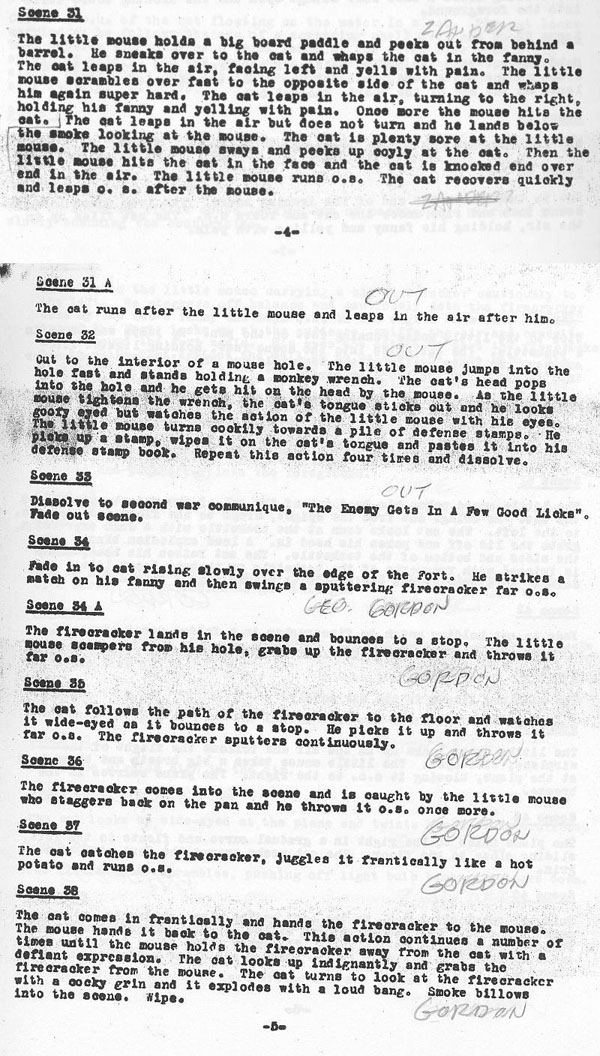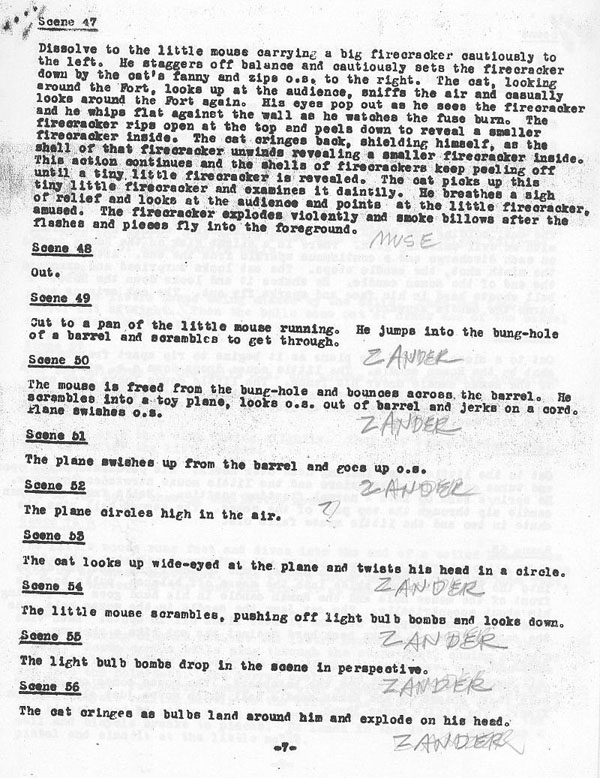
 Get out the firecrackers and Roman candles, it’s an Oscar-winning Tom and Jerry this week! (Yes, I’m aware it is after the Fourth of July, but it still fits the occasion.)
Get out the firecrackers and Roman candles, it’s an Oscar-winning Tom and Jerry this week! (Yes, I’m aware it is after the Fourth of July, but it still fits the occasion.)
By 1943, Bill Hanna and Joe Barbera’s Tom and Jerry cartoons had reached their peak, especially in their speed, by their eleventh cartoon The Yankee Doodle Mouse, under its working title “Jerry’s Home Defense.” This cartoon stands apart from the other animated films of World War II. It depicts an allegorical battle without alluding to the Axis leaders, as did many other cartoons of the period. The use of firecrackers as a weapon became a bigger staple in animation with the advent of the war; it remained a go-to solution to eliminate adversaries, especially in Warners cartoons.
The only reference that would date the film was a gag involving ration stamps, which is absent from the currently circulating re-issue version. The missing sequence is indicative from an abrupt fade-out during the sequence where Jerry continuously smacks Tom with a board, amidst a flour-encompassing smokescreen. The details of the missing scene can be seen here (below), and in the scene descriptions below that (scenes 31-33); it also explains there were intended to be three war communiqués from Jerry, instead of two in the re-issue version, released in 1951.

Layout drawing from a now-missing sequence of “The Yankee Doodle Mouse”

Hanna and Barbera’s unit of animators– consisting of Irv Spence, Ken Muse, Pete Burness, George Gordon and Jack Zander—are assigned large sections throughout the film. Spence dominates the opening scenes of combat, including the “hen grenades,” Jerry popping the projectile champagne corks, and Tom sinking into the washtub with his “ship.” Gordon animates the two throwing each other a lit firecracker before leaving an unaware Tom holding it, and Jerry being in the teakettle with another explosive. The original payoff of that sequence, as it reads in the synopsis below, of Tom appearing like a daisy with a goofy grin, reads much better than the gag in the finished film.
Burness handles Jerry’s spying on Tom with a periscope, and his use of a cheese grater, fashioned as an Army Jeep, to drive underneath Tom, with painful results. (The staggered exposure on Tom’s reactions makes the gag more unpleasant.) Zander animates a crucial point in the battle, as Jerry flies a makeshift bomber aircraft, dropping light bulbs and a banana onto Tom, before he fires a Roman candle at Jerry. Zander’s scenes also include the amusing gag of Jerry using a brassiere as a parachute.

Reissue poster
The Yankee Doodle Mouse was the first in the series to receive an Academy Award for Best Animated Short, with six subsequent victories to follow. (Their debut, 1940’s Puss Gets the Boot and 1941’s The Night Before Christmas were previously nominated, but didn’t win.) Only the second half of an original nitrate print has surfaced, but the cutting continuity indicated the original title sequence started with the animator credits first, followed by a title card of Tom and Jerry, and the main title/director credits proceeded after. The re-issue version touted the film as an Oscar-winning cartoon, displaying the statue and proclamation “Academy Award Winner of 1943,” in its main title card.
The MGM drafts shared in this column, at the moment, will be from Rudy Ising’s holdings from here on. These typewritten (and non-Ising) documents were lent to Mark Kausler from animation collector Mike Glad. It’s unclear if any more from the collection survives or which source it originated. Only the first and third pages of this draft are present, with action description pages as a substitute for the second and Kausler’s notations of the artists credited for each shot. It would be wonderful if more MGM drafts of this kind surfaced, but it’s great to know these could be shared and enjoyed. Since many of the Hanna-Barbera’s Tom and Jerry cartoons can easily be identified by the work of its animation unit, even verified by authentic documentation, a probable series of columns discussing the cartoons–especially during their 1943-48 zenith—might be used in future installments, but with only guesswork and no documentation.
Hope you all enjoyed the holidays! (Of course, I’m aware that a different Tom and Jerry released in 1950, Safety Second, occurs on the Fourth of July—enjoy that one, as well.)





(Thanks to Mark Kausler, Dave Gerstein and Thad Komorowski for their help.)


 DEVON BAXTER is a film restoration artist, video editor, and animation researcher/writer currently residing in Pennsylvania. He also hosts a
DEVON BAXTER is a film restoration artist, video editor, and animation researcher/writer currently residing in Pennsylvania. He also hosts a 





















































































Based on the layout drawing, those aren’t ration book stamps; that’s an album for stamps that you could collect, and when you’d filled the book, you could turn it in for a war bond.
The “Send More Cats!” gag is an allusion to an alleged communication from the defenders of Wake Island in December, 1941. Owing to a garble, the communication came out as “Send More Japs.” In light of the fact that Wake Island fought off the first effort by the Japanese to capture it, and the fact that December, 1941 was a very bad month for the Western Allies, the statement quickly became the 1941 equivalent of a meme. “Sighted Cat, Sank Same” has a similar history; it’s an allusion to a January, 1942 communication from a sub-chaser in the Atlantic, who signalled back “Sighted Sub, Sank Same.”
All I can say is I already like this cartoon even from not ever having seen it. This is one of those quintessential Bradley 1940’s scores, and the inventive use of sound effects throughout is something amazing. I am aware that so many bits of good source material on these cartoons burned up in the imfamous MGM fire, but I wonder whether any elements of the full original score or full sound portion of the cartoon exists in its original state, including the sound for the missing piece discussed above. This is one of those great TOM & JERRY cartoons, one that you would hold up as perfect representation of what the series is truly all about! Strange that Chuck Jones never took a piece or two of this cartoon to use for montage on the first TOM AND JERRY TV show to compile the theatricals.
I’m always struck by how stupid Pete Burness’s Tom appears to be. Unlike Ken Muse’s Tom, who is scheming, pompous and downright mean, Burness’s comes across as a mindless doofball. Interesting how a character’s persona can differ from animator to animator. It’s all subtle, and only a lunatic like myself would notice such things, but there it is…
More importantly who is the poster artist responsible for such outstanding renderings of the characters? Pure genius.
That genius is Bela Reiger – and we discuss his merits in this post: https://cartoonresearch.com/index.php/which-is-the-ugliest-mgm-cartoon-poster-nsfw/
Love the poster in Jerry’s bunker “That Friend Rat might Tell the Cat” which warns to look out for spies who might be neighborly in your hometown but might be a spy who might inform the enemy. And how they utilized household object like a brassiere for Jerry’s parachute, a cheese grater for a Jeep’s chassis and adding wings to a egg crate for a bomber.
So is the re-issue of Yankee Doodle Mouse the only existing version now? That’s something to explore, for sure. Especially if we can find old wiped episodes of Doctor Who in Nigeria…
If you look at https://www.cartoonresearch.com/mgm.html, you’ll see Jerry has posted some very, very interesting screenshots from “The Shooting of Dan McGrew” (Avery, MGM, 1945) showing two cigarette-related gags that were eliminated in the re-release of the cartoon in the 50s.
What continues to surprise me is how, seemingly, few original prints of MGM cartoons exist. At least, you never seem to see many of them (I recall not seeing the original, very pretty opening titles for “Tom and Jerry at the Hollywood Bowl” for years and years).
I’d love to see an expanded and updated discussion of MGM cartoons, and original v. reissues, here on the site. (If that’s possible, of course.)
The following is based on research David Gerstein and I did… Either by viewing rare prints or reading the copyright synopses…
Almost all of the classic Avery and H-B Tom & Jerrys were reissued at some point. One factoid: Fred Quimby did not receive screen credit until the 1946-47 season, so if his name is there any earlier, it’s a reissue.
Often the title art was revamped to conform to the widescreen ratio, and some times that called for overhauling a background pan—i.e. Texas Tom and Tom and Jerry in the Hollywood Bowl. The Early Bird Dood It! and Fine Feathered Friend were stripped of the “Hold That Tiger” MGM lion opening, and most of the T&J 1942 shorts were stripped of the “Buy War Bonds” end tag. Dumb-Hounded, Sufferin’ Cats, and Lonesome Mouse originally had the “Running Wild” opening cue that precedes Red Hot Riding Hood.
As for actual content changes, only the following comes to mind:
Dumb-Hounded — The newspaper originally had a headline that offered a pound of coffee for the killer’s capture.
Yankee Doodle Mouse — Aforementioned war bond stamp gag.
Shooting of Dan McGoo — Aforementioned cigarette gags.
Wild and Woolfy — The outlaw’s wanted poster originally offered $5,000 or “one ‘C’ Book”.
Northwest Hounded Police — Again, the wanted poster originally stipulated “below ceiling” (or something to that effect).
Lucky Ducky — The end title originally came into the screen to the conga beat.
Phew! We’ve still got lots to find, don’t we?
When MGM altered films for reissue, they had the unfortunate habit of making whatever changes they made to the original negative, not to dupe negatives, so even if those original negatives to these cartoons happened to turn up, they would almost certainly have been altered to conform to the later reissue versions. (In the same that Warner altered the original negatives when one of their cartoons received Blue Ribbon reissue treatment.) That was MGM’s procedure with feature films, and there’s no reason to think they would have done anything differently with their cartoons. The Marx Brothers’ A NIGHT AT THE OPERA, for example, was cut for a World War II-era reissue to eliminate any material indicating that the film’s opening scenes took place in Italy. The Mickey Rooney-Judy Garland musical BABES IN ARMS had a sequence removed for a late 1940s reissue in which Mickey and Judy imitated Franklyn D. and Eleanor Roosevelt. When GONE WITH THE WIND was reissued in the mid-1950s, MGM, pushed it as being “widescreen.” Actually, theater projectionists just matted the frame, cutting off the top and bottom of the film image, so that it would appear to be widescreen. A few shots in the picture had to be altered and reframed, though, so important action wouldn’t be cut off by the matte bars. Uh huh, you guessed it. MGM, in all its short-sightedness, inserted those reframed shots into the original negatives and destroyed the originals.
In some cases, the deleted footage has turned up. The missing material from BABES IN ARMS, for example, was recovered a number of years ago, but Warner is still searching for other items, like the missing material from A NIGHT AT THE OPERA.
An amazon.com review of the Dancing Lady DVD claims that the DVD is missing a scene in which Larry Fine finishes his jigsaw puzzle and is shocked to see that “It’s Hitler!”. I wonder if that’s an actual scene that was edited out when the film was re-released, or just a figment of this reviewer’s imagination, like the member of GAC Forums who was obsessed with “Droopy’s Good Deed”?
Here’s background pic from the missing sequence.
http://web.archive.org/web/20011226074450im_/http://cartoonnetwork.com/doc/tomjerry/bg/img/tjb91a.jpg